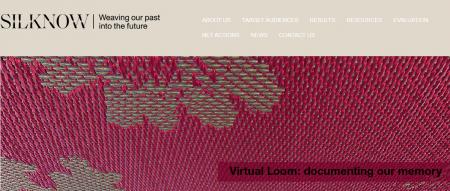SILKNOW

“SILKNOW is a research project that improves the understanding, conservation and dissemination of European silk heritage from the 15th to the 19th century. It applies next-generation computing research to the needs of diverse users (museums, education, tourism, creative industries, media…), and preserves the tangible and intangible heritage associated with silk.
Based on records from existing catalogues, it aims to produce digital modelling of weaving techniques (a “Virtual Loom”), through automatic visual recognition, advanced spatio-temporal visualization, multilingual and semantically enriched access to digital data. Its research activities and output have a direct impact in computer science and big data management, focusing on searching digital content throughout heterogeneous, multilingual and multimodal databases.
Throughout our past and present, few materials have had as important a presence as silk: economic, technical, functional, cultural and symbolic. From flags to canopies, tapestries to furniture, fans to sword sheathes, wedding gowns to traditional costumes, we can find silk in countless contexts, over the last millennia. Many people experience vivid, personal and social connections to this heritage, linked to so many life stories and collective narratives. Luxury, craftsmanship, beauty and comfort have been -and still are- associated with it. Additionally, silk trade also allowed for exchange of ideas and innovations. Punched cards were first used in Jacquard silk looms, long before modern computers were even imagined.
Nowadays, however, silk textiles are a seriously endangered heritage. There is also an associated intangible heritage -artisanal weaving techniques- at risk of disappearing. Countering those threats and making use of state-of-the-art technology, SILKNOW wants to showcase the splendor of silk, in Europe and worldwide, in the past and for the future.
What are our main goals?
- Semantically relating digitized European silk heritage, enabling data interoperability across different collections, for advanced searching abilities.
- Building a “Virtual Loom” to clone weaving techniques. This will allow users to discover the complexity, artistic and artisanal values of ancient silk textiles, while preserving them for future generations.
Improving the understanding of the European silk heritage, thanks to visual tools that show the spatio-temporal relationships of data, including an open-access, multilingual thesaurus.” (About)
